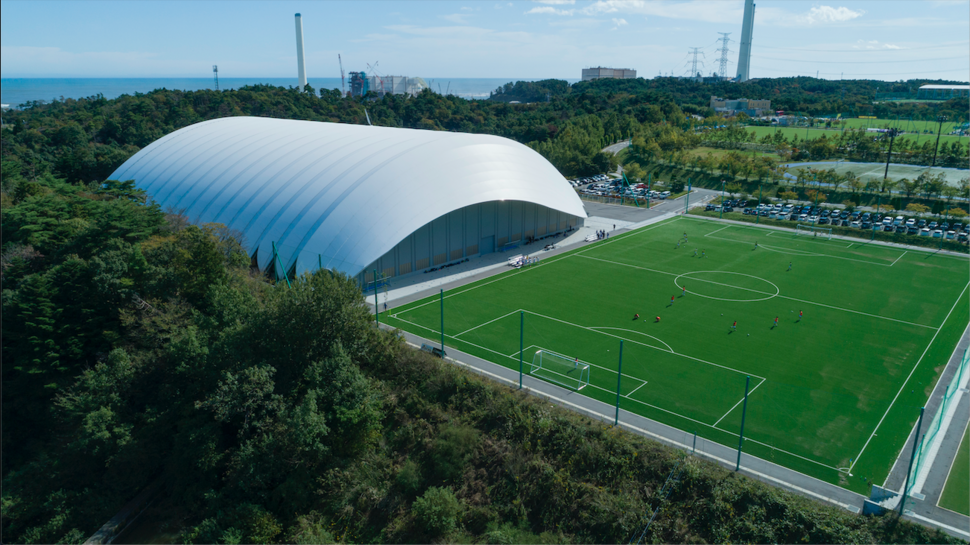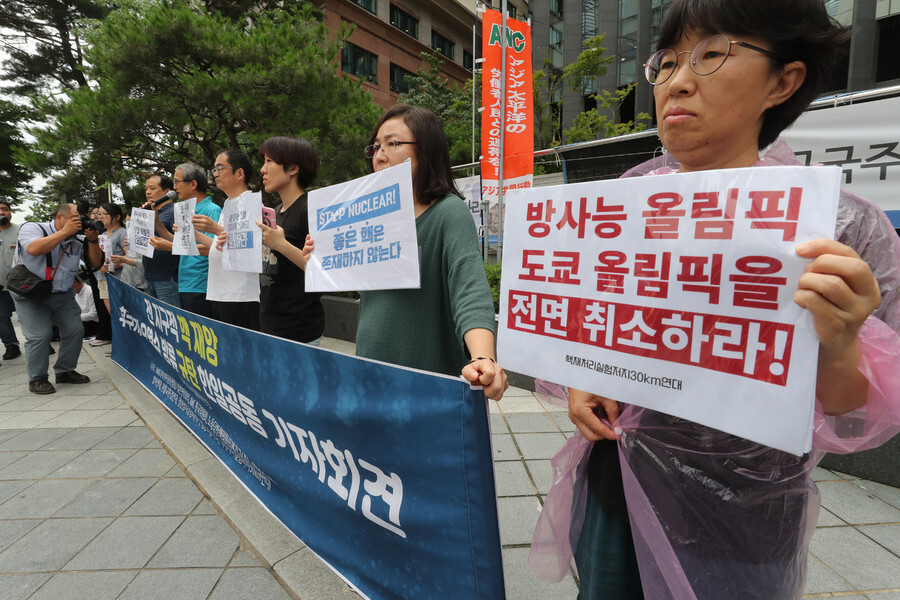hankyoreh
Links to other country sites 다른 나라 사이트 링크
Land at torch relay starting point for 2020 Tokyo Olympics found to have high levels of radiation

The land around a football stadium in Fukushima, where the torch relay is slated to begin for next year’s Tokyo Olympics, is contaminated with radiation at a level that’s 1,775 times higher than before the nuclear disaster, an environmental NGO has found. After belatedly learning about the radiation levels, the Japanese government is reportedly hurrying to decontaminate the area in question.
Greenpeace Japan announced on Dec. 4 that it had found radiation hot spots — areas where people are at risk of exposure to high doses of radiation —at J-Village, the Japan Football Association's National Training Center that includes the football stadium and training facilities for the Tokyo Olympics. J-Village is also the kickoff point for the Olympic torch relay.

Greenpeace has been measuring radioactive contamination around Fukushima every year since the nuclear accident there. With the Tokyo Olympics coming up, the group checked radiation readings in areas around Fukushima, including J-Village, for four weeks, between October and November. The group’s investigators found high levels of radiation in parking lots and areas landscaped with grass and trees around the football training center.
Radioactivity readings at a parking lot near the football stadium were as high as 71 microsieverts an hour. That’s 1,775 times higher than the level prior to the Fukushima nuclear accident, Greenpeace explained. Except for the radioactive hot spots, radioactivity around J-Village was generally found to be lower than other parts of Fukushima.
At the end of November, Greenpeace forwarded the results of its survey to Japanese Environment Minister Shinjiro Koizumi, Japanese Olympic Committee President Yasuhiro Yamashita, and International Olympic Committee President Thomas Bach. The NGO recommended that the radioactive hot spots near the football field be quickly decontaminated and that the area be closed to the general public until safety could be fully guaranteed.
The Japanese government’s initial response came through the press. Japanese newspaper Sankei Shimbun reported on the survey results that Greenpeace submitted to the Japanese government and said that Tokyo Electric Power had carried out decontamination work on Dec. 3, removing soil from the areas in question, at the request of the Ministry of the Environment.
“The fact that the Japanese government didn’t know about the existence of the radioactive hot spots at J-Village until the Greenpeace survey shows the extent of its complacency in regard to the Fukushima issue. Greenpeace’s survey of J-Village was extremely limited, only lasting for two hours. The Japanese government needs to block public access to J-Village until it has meticulously remeasured radiation levels in the area and made the exact readings public,” said Chang Mari, a climate and energy campaigner for Greenpeace Korea.
Greenpeace activists will soon be returning to Fukushima to carry out further measurements of radioactivity around J-Village.
Originally built by Tepco opened in 1997, J-Village was Japan’s first national training center for soccer. It is located about 20km from Tepco’s Fukushima Daichi Power Plant, which suffered one of the world’s worst nuclear accidents in 2011.
J-Village functioned for years as a logistics hub for crews working to control and decommission the defunct reactors. After a cleanup process, the sports center became fully operational again in April this year, shortly after the torch relay decision.
By Choi Ye-rin, staff reporter
Please direct comments or questions to [english@hani.co.kr]

Editorial・opinion
![[Editorial] Does Yoon think the Korean public is wrong? [Editorial] Does Yoon think the Korean public is wrong?](https://flexible.img.hani.co.kr/flexible/normal/500/300/imgdb/original/2024/0417/8517133419684774.jpg) [Editorial] Does Yoon think the Korean public is wrong?
[Editorial] Does Yoon think the Korean public is wrong?![[Editorial] As it bolsters its alliance with US, Japan must be accountable for past [Editorial] As it bolsters its alliance with US, Japan must be accountable for past](https://flexible.img.hani.co.kr/flexible/normal/500/300/imgdb/original/2024/0417/6817133413968321.jpg) [Editorial] As it bolsters its alliance with US, Japan must be accountable for past
[Editorial] As it bolsters its alliance with US, Japan must be accountable for past- [Guest essay] Amending the Constitution is Yoon’s key to leaving office in public’s good graces
- [Editorial] 10 years on, lessons of Sewol tragedy must never be forgotten
- [Column] A death blow to Korea’s prosecutor politics
- [Correspondent’s column] The US and the end of Japanese pacifism
- [Guest essay] How Korea turned its trainee doctors into monsters
- [Guest essay] As someone who helped forge Seoul-Moscow ties, their status today troubles me
- [Editorial] Koreans sent a loud and clear message to Yoon
- [Column] In Korea’s midterm elections, it’s time for accountability
Most viewed articles
- 1[Column] The clock is ticking for Korea’s first lady
- 2[Editorial] When the choice is kids or career, Korea will never overcome birth rate woes
- 3[Guest essay] How Korea turned its trainee doctors into monsters
- 4[Editorial] As it bolsters its alliance with US, Japan must be accountable for past
- 5S. Korea, Japan reaffirm commitment to strengthening trilateral ties with US
- 6Korea, Japan jointly vow response to FX volatility as currencies tumble
- 7Gangnam murderer says he killed “because women have always ignored me”
- 8Japan officially says compensation of Korean forced laborers isn’t its responsibility
- 9[News analysis] After elections, prosecutorial reform will likely make legislative agenda
- 10‘Right direction’: After judgment day from voters, Yoon shrugs off calls for change